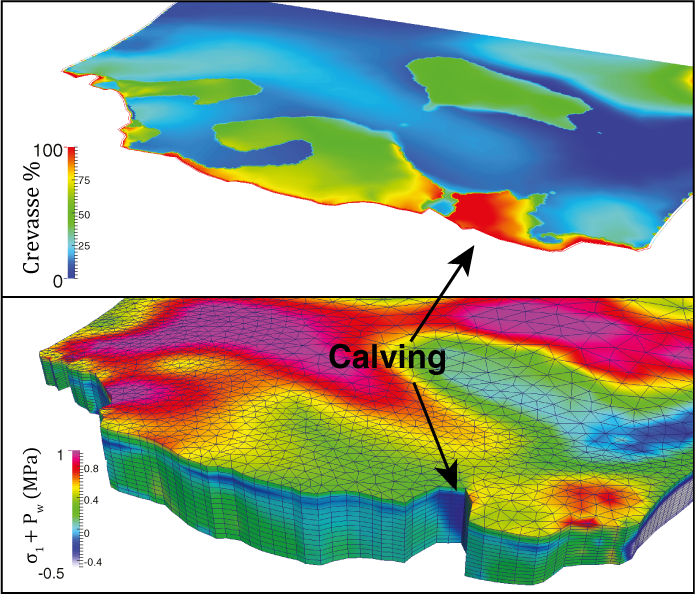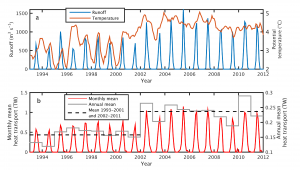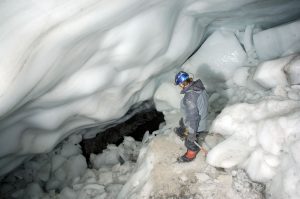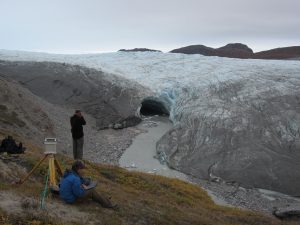Research themes
Modelling Calving Glaciers:
By Joe Todd

Calving glaciers represent the ‘ice’ side of ice/ocean interactions. Doug has been interested in trying to understand the dynamics of calving glaciers for several years. Our present research in this subject involves implementing the crevasse depth calving criterion into 3D full-Stokes dynamics models for outlet glaciers, primarily undertaken by Joe. This links naturally with the fjord and plume modelling work being led by Tom.
Joe has been developing 2D and 3D calving models for the very capable, versatile and scalable model Elmer/Ice. The figure to the left shows how the model collapses the 3D stress state into a plane to identify calving. The video below shows the 3D model for Store Glacier in action! The most challenging aspect of this work has been the rediscretisation of the 3D model domain following changes in geometry.
This research aims to improve our understanding of calving mechanisms, and shed light on the processes which link calving and climate. So far, a case study of Store Glacier, West Greenland, has revealed the significant stabilising effect that ice mélange can exert on the terminus, as well as the importance of submarine melt distribution in affecting calving. Future work will compare the results from Store Glacier with other outlet glaciers, to investigate observed differences between glaciers.
This clip shows an early iteration of the 3D calving model in action. Colours on the surface show ice velocity and brief flashes on the ice/ocean terminus represent individual calving events. On the base, red regions are grounded while blue regions are floating. Remeshing following calving events are visible.
Surge Glacier Dynamics:
By Heïdi Sevestre
 Surging glaciers make up only a tiny proportion of the world’s population of glaciers, but they have a great deal to tell us about the fundamental processes that govern all glacier behaviour. Together with Adrian Luckman at the University of Swansea, Doug and Heidi have been working on several aspects of surge phenomena, including observing land-based and tidewater surging glaciers in Svalbard, analysing the controls on the global distribution of surges, and developing a unified model of surging. In recent papers they outlined a new enthalpy cycle model of glacier surging, which links glacier dynamics to energy exchanges with the environment. A fully quantitative model is in development.
Surging glaciers make up only a tiny proportion of the world’s population of glaciers, but they have a great deal to tell us about the fundamental processes that govern all glacier behaviour. Together with Adrian Luckman at the University of Swansea, Doug and Heidi have been working on several aspects of surge phenomena, including observing land-based and tidewater surging glaciers in Svalbard, analysing the controls on the global distribution of surges, and developing a unified model of surging. In recent papers they outlined a new enthalpy cycle model of glacier surging, which links glacier dynamics to energy exchanges with the environment. A fully quantitative model is in development.
Fjord circulation and ocean melting of glaciers

By Tom Cowton
Many of Greenland’s marine-terminating outlet glaciers have undergone a dramatic retreat since the late 1990s, far exceeding the rate of change observed at neighbouring land-terminating glaciers. This contrast in behaviour between marine and land terminating glaciers indicates that the recent warming of ocean waters around Greenland may be a key factor driving the loss of mass from the ice sheet. However, the extent to which oceanic warming is experienced by the glaciers, which are typically separated from the open ocean by lengthy fjords, remains unclear.
To investigate this, I have conducted a series of modelling experiments focussed on the circulation of waters in Kangerdlugssuaq Fjord, east Greenland, using an ocean general circulation model (MITgcm). These experiments indicate that input of meltwater runoff from glaciers at the fjord head is a key mechanism driving circulation in the fjord: a mixture of melt water and fjord waters flows down-fjord in the upper part of the water column, generating a compensatory up-fjord flow of deep, warm ocean waters below. Because the strength of this circulation increases with the input of meltwater, this means that increased melting of the ice sheet surface during warmer summers may lead to more warm ocean water being drawn into the fjords, and so also facilitate increased melting of the ice sheet margins by the ocean. How significant this feedback is remains the subject of onging research.
I am also interested in how circulation of fjord waters directly influences melting of the glacier termini. Glacial meltwater is less dense than seawater, and so rises towards the fjord surface as a vigorous plume. These plumes increase the rate of ice melt where they come into contact with the glacier, and so may be an important control on marine-terminating glacier stability. By combining the modelling of these plumes with Joe and Doug’s modelling of calving mechanics, we hope to determine whether this localised enhanced melting can play an important role in the retreat of marine-terminating glaciers.
Hydrology and dynamics of the Greenland Ice Sheet
By Tom Cowton
Meltwater forming on the surface of the ice sheet during the summer months is able to penetrate to the ice sheet bed, where it then influences the sliding motion of the overlying ice. If the greater volumes of meltwater produced in warmer summers result in the ice sheet sliding faster, then this could lead to the ice sheet wasting more rapidly as the climate warms.
For my PhD research, I joined from the University of Edinburgh and University of Aberdeen a team to investigate this hypothesis. To this end, we undertook several lengthy field campaigns to obtain high resolution observations of the hydrology and dynamics of Leverett Glacier, a land-terminating outlet glacier on the western margin of the Greenland Ice Sheet. One of my main roles was to use tracing experiments to determine the form of the subglacial drainage pathways, work which provided the first direct evidence of efficient subglacial drainage channels beneath the Greenland Ice Sheet. Following this, I undertook hydrological modelling experiments to examine the relationship between meltwater runoff, subglacial water pressure and recorded ice motion, concluding that the largest fluctuations in ice motion occurred due to the expansion of water filled cavities at the bed at times when meltwater runoff was increasing.
As a whole, our findings indicate that while the input of meltwater increases average ice velocities during the summer months, this is offset by a subsequent decrease in ice velocity during the autumn and early winter, resulting in little net variation in ice motion from one year to the next.
Glacial erosion and geomorphology
As part of our investigation into the hydrology of Leverett Glacier, we collected several years of sediment flux data from the proglacial driver. This provided a unique opportunity to assess the erosive power of Greenland’s outlet glaciers. The calculated erosion rates indicate that Greenland’s outlet glaciers are capable of eroding their bed 1-2 orders of magnitude faster than was widely assumed, allowing new insight into the rapid rate at which ice sheets are capable of modifying the landscape.
Response of Himalayan glaciers to climate change
By Doug Benn
I first visited the Himalaya in 1993, working with my friend and colleague Lewis Owen on the chronology of Quaternary glaciations in the Lahul region of India. In 1995, Lewis and I turned our attention to the Khumbu Himalaya, south of Mount Everest, using luminescence dating techniques to constrain moraine ages and reconstruct the climate of Last Glacial Maximum. As part of that work, I realized how little was understood about how Himalayan glaciers respond to climate change in general, including modern warming. So in 1998, I started a program of work on debris-covered glaciers in the Mount Everest region, aiming to understand the controls on glacier mass balance. That season, I first visited Ngozumpa Glacier with my PhD student Seonaid Wiseman, and we realised that it was an ideal field site for investigating a wide range of processes including the role of suface debris on melt rates, the formation and drainage of supraglacial lakes, and glacier lake outburst flood (GLOF) hazards. During subsequent trips to Ngozumpa Glacier and other glaciers in the region with PhD students Kat Hands, Lindsey Nicholson and Sarah Thompson, and colleagues Jason Gulley and Adrian Luckman, we gradually came to understand how these glaciers work. In addition to fieldwork, we have used a range of satellite imagery to determine long-term rates of mass loss, patterns of lake evolution, and rates of ice flow. During the last 20 years, we have also been witnesses to the stagnation, decay and death of large parts of these glaciers, as they succumbed to the effects of climate warming.

Glacio-speleology
By Doug Benn

One of the unexpected research directions that emerged from the Himalayan project was glacio-speleology – the direct exploration of and study of englacial and subglacial drainage systems, or ‘ice caves’. From the first field visit to Ngozumpa Glacier in 1998, it was obvious that supraglacial ponds and lakes could drain into englacial conduits, and that drainage systems therefore could extert an important control on the life-time of lakes, and hence patterns and rates of melting on the glacier surface. For some time, I wondered about the possibility of using geophysical methods such as Ground Penetrating Radar to image subsurface features. This works well on clean glaciers, but where there is a debris cover, too much of the energy is scattered and deeper features are obscured. So that seemed to be a dead end. Then, while visiting Svalbard, I discovered that there was such a thing as ice caving and began to wonder if might work in the Himalaya. This was a thought I kept trying to suppress, until I met Jason Gulley while I was visiting Lewis Owen in Cincinnatti. Jason was (and still is) fanatically interested in caves of all kinds, and over several beers we discussed the idea of Himalayan ice caving and before closing time we had agreed to do it. Just over a year later, we completed our first trip, exploring and mapping caves in Khumbu, Ama Dablam, Lhotse and Ngozumpa Glaciers. Since then, we conducted numerous trips in the Himalaya and Svalbard, doing a lot of great science and having quite a few wild adventures along the way. Ice caving research has come a long way since those early trips, when even the mechanisms of conduit formation were unknown. Now, the focus is more on hydrological processes, such as the controls on roughness and flow resistance, and studying otherwise inaccessible subglacial environments

